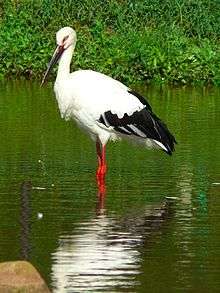Oriental stork
The Oriental stork (Ciconia boyciana) is a large, white bird with black wing feathers in the stork family Ciconiidae. The species was first described by Robert Swinhoe in 1873. It is closely related to and resembles the European white stork (C. ciconia), of which it was formerly often treated as a subspecies. It is typically larger than the white stork, at 100–129 cm (39.5–51 in) long, 110–150 cm (43–59 in) tall, a weight of 2.8–5.9 kg (6.2–13.0 lb) and a wingspan of 2.22 m (7.3 ft).[2][3] Unlike its more widespread cousin, the Oriental stork has red skin around its eye, with a whitish iris and black bill. Both sexes are similar. The female is slightly smaller than male. The young are white with orange bills.
| Oriental stork | |
|---|---|
 | |
| Scientific classification | |
| Kingdom: | Animalia |
| Phylum: | Chordata |
| Class: | Aves |
| Order: | Ciconiiformes |
| Family: | Ciconiidae |
| Genus: | Ciconia |
| Species: | C. boyciana |
| Binomial name | |
| Ciconia boyciana R. Swinhoe, 1873 | |
| Distribution map of Oriental stork Yellow: breeding Blue: non breeding | |
At one time, the Oriental stork could be found in Japan, Manchuria, Korea and Siberia. It is now extinct in Japan and the Korean peninsula. However, in May 2007 a hatchling was reported in Japan for the first time in 40 years in the wild. It was offspring of two storks who were bred in captivity.[4] There have been efforts to reintroduce the storks to the wild, but there must be changes to the environment first.[5] The storks were harshly impacted by the growth of the rice industry and the subsequent use of pesticides.[6][7] There is a push for rice farmers to grow their plants organically so that the storks may breed and grow safely in their environments.[8] After breeding, the storks migrate to eastern China in September and return in March.[9][10]
The Oriental stork is a solitary bird except during the breeding season. Its diet consists mainly of fish, frogs, insects, small birds and reptiles, as well as rodents. The female usually lays between two and six eggs.
The scientific name commemorates Robert Henry Boyce.
Due to habitat loss and overhunting, the Oriental stork is classified as endangered on the IUCN Red List of Threatened Species.[1] It is listed on Appendix I of CITES.
See also
References
- BirdLife International (2013). "Ciconia boyciana". IUCN Red List of Threatened Species. 2013. Retrieved 26 November 2013.CS1 maint: ref=harv (link)
- Hancock & Kushan, Storks, Ibises and Spoonbills of the World. Princeton University Press (1992), ISBN 978-0-12-322730-0
- CRC Handbook of Avian Body Masses by John B. Dunning Jr. (Editor). CRC Press (1992), ISBN 978-0-8493-4258-5
- Endangered white storks hatch egg, Steve Jackson, BBC News, 20 May 2007.
- "Sustaining Agrarian Futures | Anthropology-News". www.anthropology-news.org. Retrieved 2018-07-18.
- Tatlow, Didi Kirsten. "Endangered and Targeted: Fight to Save Oriental Stork Captivates China". IHT Rendezvous. Retrieved 2018-07-18.
- "Japan looks to ancient wisdom to save biodiversity". Retrieved 2018-07-18.
- "Reintroducing the oriental white stork in Toyooka City | Payments for ecosystem services (PES)". www.biodic.go.jp. Retrieved 2018-07-18.
- "Ciconia boyciana (Japanese White Stork, Oriental Stork, Oriental White Stork)". IUCN Red List of Threatened Species. Retrieved 2018-07-18.
- "Oriental Stork (Ciconia boyciana) - BirdLife species factsheet". datazone.birdlife.org. Retrieved 2018-07-18.
External links
| Wikimedia Commons has media related to: |
| Wikispecies has information related to Ciconia boyciana |
